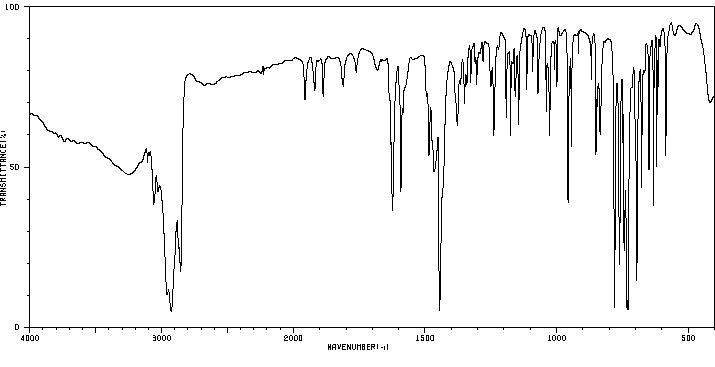(α-Chlorobenzylidene)fluorene | 86457-77-4
中文名称
——
中文别名
——
英文名称
(α-Chlorobenzylidene)fluorene
英文别名
9-(α-chloro-benzylidene)-fluorene;9-(α-Chlor-benzyliden)-fluoren;β-Chlor-β-phenyl-α,α-biphenylen-ethylen;β-Chlor-β-phenyl-α,α-diphenylen-ethylen;9-<α-Chlor-benzyliden>-fluoren;9-(Alpha-chlorobenzylidene)fluorene;9-[chloro(phenyl)methylidene]fluorene
CAS
86457-77-4
化学式
C20H13Cl
mdl
——
分子量
288.776
InChiKey
BIHPCWNKBDTFRL-UHFFFAOYSA-N
BEILSTEIN
——
EINECS
——
-
物化性质
-
计算性质
-
ADMET
-
安全信息
-
SDS
-
制备方法与用途
-
上下游信息
-
文献信息
-
表征谱图
-
同类化合物
-
相关功能分类
-
相关结构分类
计算性质
-
辛醇/水分配系数(LogP):5.6
-
重原子数:21
-
可旋转键数:1
-
环数:4.0
-
sp3杂化的碳原子比例:0.0
-
拓扑面积:0
-
氢给体数:0
-
氢受体数:0
上下游信息
反应信息
-
作为反应物:描述:(α-Chlorobenzylidene)fluorene 以 乙腈 为溶剂, 生成 、参考文献:名称:Photochemical Formation and Electrophilic Reactivities of Vinyl Cations. Influence of Substituents, Anionic Leaving Groups, Solvents, and Excitation Wavelength on Photoheterolysis and Photohomolysis of 1-(p-R-Phenyl)-2-(2,2'-biphenyldiyl)vinyl Halides摘要:Using product analysis and time-resolved laser flash photolysis techniques, the photochemistry at lambda(exc) approximate to 250 and 310 nm (exe = excitation) of 1-(p-R-phenyl)-2-(2,2'-biphenyldiyl)vinyl halides (R = H, Me, MeO) in methanol and acetonitrile at room temperature was studied. The title compounds undergo photoheterolysis and photohomolysis to give vinyl cations =C+- (carbenium ions) and vinyl radicals =C-.-. The cation: radical ratio increases with electron-donating strength of the substituent R, H < Me < MeO, and with anionic leaving group power of the halide, F- < Cl- < Br- < I-, indicating that the cleavage of the C-X bond to yield cation and halide anion proceeds, in the rate-determining step, by heterolysis and not by homolysis followed by electron transfer in the radical pair. The cation:radical ratio is solvent dependent: e.g., for the vinyl bromide with R = MeO and with lambda(exc) = 308 nm, in CH2Cl2 as solvent, only radical is observed, in comparison with only cation in the much more polar solvent acetonitrile. In acetonitrile-methanol mixtures, the absolute yields of both cation and radical go through a maximum as the methanol content is increased, however, the cation:radical ratio decreases continuously with increasing [MeOH]. For a particular R, the quantum yield for C-X bond cleavage is higher at approximate to 250 than at approximate to 310 nm. Also, the cation:radical ratio is wavelength-dependent: at lambda(exc) approximate to 310 nm there is relatively more heterolysis than at lambda(exc),,, x 250 nm. Rate constants for reaction of the cations with nucleophiles were determined in acetonitrile. Those for reaction of the cation with R = MeO (lifetime in acetonitrile 7 ys) with anionic nucleophiles such as the halides are at the diffusion limit in this solvent, approximate to 2 x 10(10) M(-1) s(-1), whereas those for reaction with water, alcohols, and cyclic ethers are of the order 10(5)-10(6) M(-1) s(-1). The less stabilized cation (R = Me) reacts with alcohols faster by the factor approximate to 100, and it decays in acetonitrile approximate to 100 times more rapidly. Also, 1-(p-a-phenyl)-2-dimethylvinyl bromides (R = H, Me, MeO) were photolyzed in acetonitrile. In the case of R = MeO, the cation p-CH3O-C6H4-C+=CMe(2) was seen (lifetime 770 ns), and its reactivity with alcohols (k values of 10(6)-10(7) M(-1) s(-1)) and halides (k values of 10(10) M(-1) s(-1)) was determined. The vinyl radicals =C-.- react with O-2 to yield vinylperoxyl radicals =C-O-2(.) which have absorption maxima at approximate to 390 nm.DOI:10.1021/j100089a027
-
作为产物:描述:参考文献:名称:Synthesis with .alpha.-heterosubstituted phosphonates. Part 13. Synthesis of trisubstituted vinyl chlorides摘要:DOI:10.1021/jo00164a036
文献信息
-
Kuhn,R. et al., Justus Liebigs Annalen der Chemie, 1962, vol. 654, p. 64 - 81作者:Kuhn,R. et al.DOI:——日期:——
-
Staudinger; Siegwart, Helvetica Chimica Acta, 1920, vol. 3, p. 838作者:Staudinger、SiegwartDOI:——日期:——
-
Reimlinger,H., Chemische Berichte, 1964, vol. 97, p. 339 - 348作者:Reimlinger,H.DOI:——日期:——
表征谱图
-
氢谱1HNMR
-
质谱MS
-
碳谱13CNMR
-
红外IR
-
拉曼Raman
-
峰位数据
-
峰位匹配
-
表征信息
同类化合物
(S)-2-N-Fmoc-氨基甲基吡咯烷盐酸盐
(2S,4S)-Fmoc-4-三氟甲基吡咯烷-2-羧酸
黎芦碱
鳥胺酸
魏因勒卜链接剂
雷迪帕韦二丙酮合物
雷迪帕韦中间体6
雷迪帕韦
雷迪帕维中间体
雷迪帕维中间体
雷尼托林
锰(2+)二{[乙酰基(9H-芴-2-基)氨基]氧烷负离子}
醋酸丁酸纤维素
达托霉素杂质
赖氨酸杂质4
试剂9,9-Dioctyl-9H-fluoren-2-amine
螺[环戊烷-1,9'-芴]
螺[环庚烷-1,9'-芴]
螺[环己烷-1,9'-芴]
螺[3.3]庚烷-2,6-二-(2',2'',7',7''-四碘螺芴)
螺-(金刚烷-2,9'-芴)
螺(环己烷-1,9'-芴)-3-酮
藜芦托素
荧蒽 反式-2,3-二氢二醇
草甘膦-FMOC
英地卡胺
苯芴醇杂质A
苯甲酸-(芴-9-基-苯基-甲基酯)
苯甲酸-(9-苯基-芴-9-基酯)
苯并[b]芴铯盐
苯并[a]芴酮
苯基芴胺
苯基(9-苯基-9-芴基)甲醇
苯(甲)醛,9H-芴-9-亚基腙
苯(甲)醛,4-羟基-3-甲氧基-,(3-甲基-9H-茚并[2,1-c]吡啶-9-亚基)腙
芴甲氧羰酰胺
芴甲氧羰酰基高苯丙氨酸
芴甲氧羰酰基肌氨酸
芴甲氧羰酰基环己基甘氨酸
芴甲氧羰酰基正亮氨酸
芴甲氧羰酰基D-环己基甘氨酸
芴甲氧羰酰基D-Β环己基丙氨酸
芴甲氧羰酰基-O-三苯甲基丝氨酸
芴甲氧羰酰基-D-正亮氨酸
芴甲氧羰酰基-6-氨基己酸
芴甲氧羰基-高丝氨酸内酯
芴甲氧羰基-缬氨酸-1-13C
芴甲氧羰基-叔丁基二甲基硅-D-丝氨酸
芴甲氧羰基-beta-赖氨酰酸(叔丁氧羰基)
芴甲氧羰基-S-叔丁基-L-半胱氨酸五氟苯基脂








